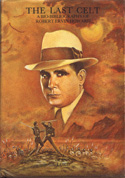
|
|
The Last Celt: A Bio-Bibliography of Robert Ervin Howard
has been the "bible" of Robert E. Howard (REH) admirers since it
was first published in 1976 by D.M. Grant Publishers. The book is
416 pages, and contains essays by people who knew Howard personally,
well known writers whose work Howard influenced, and REH scholars.
It also contains rare letters, synopses, story fragments, photos,
and ephemera relating to Howard's life. The second half of the book
is dedicated to an extremely well organized and complete bibliography
of all of Howard's fiction, poetry, essays, and other work catalogued
up through December 31, 1973. The Last Celt was also published in
trade paperback by Berkley Windhover Books in 1977. Both editions
are currently out of print.
Without this book, collecting REH's work would be impossible.
There is no doubt that we owe a debt of gratitude to Glenn Lord
for his dilligence, enthusiasm, and foresight in compiling and
making available this invaluable resource of Howard's life and
work.
Highly recommended! A+
|
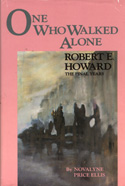
|
|
One Who Walked Alone: Robert E. Howard The Final Years,
published by D.M. Grant in 1986, is one of the best sources of biographical
information we have of Robert E. Howard (REH). This memoir is a
first hand account of Robert E. Howard as seen through the eyes
of Novalyne Price Ellis, who was a close friend of Howard's. Using
her old diaries and journals, Mrs. Ellis weaves together an enchanting
and surprisingly entertaining account of her friendship with REH.
One Who Walked Alone accomplishes an amazing feat; it succeeds
in giving us perspective and an understanding of the community and
times in which Howard lived... and gives the reader a level of insight
into Howard that, aside from REH's own personal letters, no other
source has matched.
The book was also used as the basis for the acclaimed motion
picture about Robert E. Howard, The Whole Wide World. Unfortunately,
the book has long since sold out and is currently out of print.
However, a new, third printing of the book is expected to be available
beginning December 1st, 1998 from
Donald M. Grant Publishers.
Highly recommended! A+
|
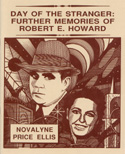
|
|
Day of the Stranger: Further Memories of Robert E. Howard
by Novalyne Price Ellis is a follow-up to One Who Walked Alone.
Interviewed with insightful questions by the REH scholar, Rusty
Burke, Novalyne answers questions raised by her first book and gives
us more insight and memories of the man, Robert E. Howard. This
chapbook is an essential companion to One Who Walked Alone.
Day of the Stranger also includes a rare short radio
play by the same name, written by Mrs. Ellis in 1947 for a college
project. The play is about an incident 2 years after Howard's
death, when she thought she saw him boarding a bus in Houston.
This chapbook was first published in 1989 by
Necronomicon Press, but is now out of print.
HIghly recommended! A
|
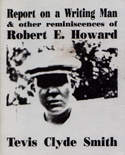
|
|
Report On a Writing Man & Other Reminiscences of Robert E.
Howard by Tevis Clyde Smith was first published in 1991 by Necronomicon
Press. This chapbook features important essays, poetry, and ephemera
on Howard by his best friend, Tevis Clyde Smith. For years, Mr.
Smith intended on writing a biography on Howard, but the money and
time never came through. Instead, his writings on Howard were mostly
confined to introductions for a multitude of books. Assembled for
the first time in one volume by Rusty Burke, these introductions
show a side of Howard that could have only been conveyed by a best
friend. Though Mr. Smith never wrote a REH biography, he did make
some notes for a biography that was planned, and these jewels appear
in this volume for the first time.
Also included in Report on a Writing Man is a quirky
short play written by Mr. Smith about a conversation he and Howard
had on a bridge. Other rare material makes its way into the book
such as copies of The All Around Magazine which was Howard's
and Smith's first amateur magazine that features the only published
reproduction of the duo-authored story, "Under the Great Tiger".
This chapbook ends with an excellent biographical essay on Tevis
Clyde Smith by Rusty Burke. At times lighthearted with the exuberance
of youth, and others deadly serious, this book gives the reader
rare and invaluable insight into Robert E. Howard's character.
Report on a Writing Man is still in print and currently
available through
Necronomicon Press.
Highly recommended! A
|
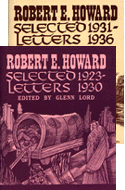
|
|
Robert E. Howard Selected Letters, Vol. 1 and 2 gives the
reader perhaps the most important insight into Howard's life and
work. Without reading these letters, one can not begin to
understand how Howard's stories transcend the mere entertaining
quality of his work, to express complex ideas regarding the nature
of life, man, and society in the guise of adventure. In these letters,
Howard explains what he meant by "barbarism", how he viewed his
characters, and what he tried to accomplish with his stories. He
explains his hopes and dreams, his tradgedies and mistakes, and
his love for freedom and writing.
These letters are absolutely essential for anyone trying to
understand Howard's literature and life. If you only read one
piece of biographical material on Howard, this should be the item
you pick up. First published in 1989 and 1991 respectively, these
two volumes of letters are still in print and available from
Necronomicon Press.
Greatly recommended! A++
|
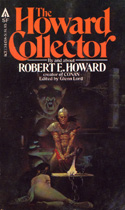 |
|
The Howard Collector is a collection of rare REH ficiton,
poetry, essays, letters, and articles that previously appeared in
the small, limited run fanzine of the same name. Editied and compiled
by the past literary agent for the Howard heirs, Glenn Lord, this
book surpasses all expectations of quality and significance. This
is an excellent book, worthy of admiration from the most jaded Howardphile.
Highly recommended! A
|
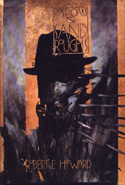
|
|
Post Oaks and Sand Roughs by Robert E. Howard is a semi-autobiographical
novel centering around Howard's friends and acquaintances and the
towns in which they lived. The principle characters and places found
in the book are thinly veiled under such fictional names as, "Lost
Plains" (AKA Cross Plains), "Redwood" (AKA Brownwood), "Steve Constigan"
(AKA Howard himself), etc. The book relates events that occured
in Howard's life sometime between 1924 and 1928, when REH was 18-22
years of age.
Post Oaks is an excellent source for acquiring new insight
into Howard's emotional state; his loves, his fears, his hates,
etc. About the book Howard himself wrote:
| I... know it won't be accepted. I wouldn't take it myself
if I were a publisher... I've cursed out every known cult,
creed and nationality in it; if any man takes it, he'll be
either unusually broad-minded or else a misanthrope. |
Although one is tempted to read this book as if it were a true
autobiography, the fact that it is a fictional novel can not be
overlooked. There are indeed a great many gems contained within
this book, and many of the events related here also correspond
with actual events found in Howard's letters. Still, when an author
is writing a fictional book, even if it is close to home,
the urge to enhance and embellish the story in order to make it
more interesting is hard to fight. This necessarily makes the
accuracy of the book suspect.
Published for the first time by D.M. Grant Publishers in 1990,
Post Oaks and Sand Roughs is a marvellous curiosity; and
a valuable, somewhat hazy look into the life of Robert E. Howard.
The book is currently out of print and only available from used
book dealers.
Highly recommended!
|
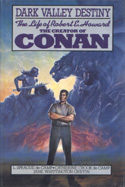
|
|
Dark Valley Destiny: The Life of Robert E. Howard by L.
Sprague and Catherine Cook de Camp was published in 1983 by Bluejay
Books. Actually, the book is based on an essay L. Spague de Camp
wrote back in 1961 called "The Miscast Barbarian," whch de Camp
expanded into this book. Although Dark Valley Destiny includes
exclusive information from individuals who knew Howard and have
long since passed away, this book is severely flawed.
Dark Valley Destiny was originally commissioned as a
kind of double psychological evalutation of Howard's psyche and
biography. Unfortunately, the person doing the observations was
a writer and not a psychologist, so it is no surprise that erroneous
and misleading conclusions about Howard's character appear throughout
the book. This error alone might not have condemmed this book
to the worst of Howard biographies, but de Camp's writing style
takes these hypotheses and erroneous judgements and presents them
as fact. Nearly 90% of the book is taken up by pure opinion and
speculation hidden to appear as statements of fact. In addition,
de Camp allows his own biases and poor estimation of Howard's
character and literature to influence his research and conclusions.
On more than one occasion de Camp brands Howard with the overgeneralized
and simplistic statement that he was "crazy," he proliferates
the ridiculous opinion that Howard suffered from an Oedipus complex,
and slanders Howard's work by stating emphatically that the stories
have no other significance than their ability to entertain and
excite readers. It is well known that de Camp had a hate/love
relationship with Howard and his stories. Regardless of his feelings
for the literature and the man who created it, de Camp simply
may not have had the ability understand Howard's life or work.
When dealing with such an unconventional and complex individual
as Robert E. Howard, it takes a certain type of person who is
able to overlook their own biases to get at the truth... and in
this, de Camp and his book, Dark Valley Destiny, fail miserably.
Poor research methods and writing, along with numerous biased,
unsubstantiated, and misleading statements, give this book the
honor of the worst book ever written about Robert E. Howard.
Avoid at all costs! F
|
|

